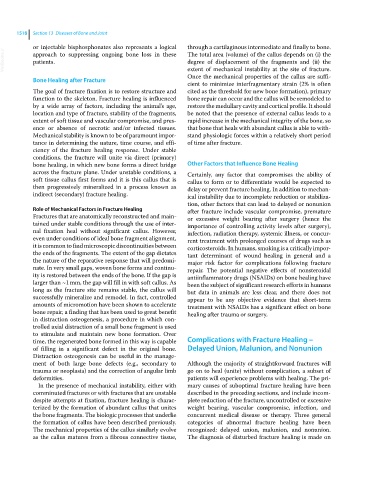Page 1580 - Clinical Small Animal Internal Medicine
P. 1580
1518 Section 13 Diseases of Bone and Joint
or injectable bisphosphonates also represents a logical through a cartilaginous intermediate and finally to bone.
VetBooks.ir approach to suppressing ongoing bone loss in these The total area (volume) of the callus depends on (i) the
degree of displacement of the fragments and (ii) the
patients.
extent of mechanical instability at the site of fracture.
Once the mechanical properties of the callus are suffi-
Bone Healing after Fracture
cient to minimize interfragmentary strain (2% is often
The goal of fracture fixation is to restore structure and cited as the threshold for new bone formation), primary
function to the skeleton. Fracture healing is influenced bone repair can occur and the callus will be remodeled to
by a wide array of factors, including the animal’s age, restore the medullary cavity and cortical profile. It should
location and type of fracture, stability of the fragments, be noted that the presence of external callus leads to a
extent of soft tissue and vascular compromise, and pres- rapid increase in the mechanical integrity of the bone, so
ence or absence of necrotic and/or infected tissues. that bone that heals with abundant callus is able to with-
Mechanical stability is known to be of paramount impor- stand physiologic forces within a relatively short period
tance in determining the nature, time course, and effi- of time after fracture.
ciency of the fracture healing response. Under stable
conditions, the fracture will unite via direct (primary)
bone healing, in which new bone forms a direct bridge Other Factors that Influence Bone Healing
across the fracture plane. Under unstable conditions, a Certainly, any factor that compromises the ability of
soft tissue callus first forms and it is this callus that is callus to form or to differentiate would be expected to
then progressively mineralized in a process known as delay or prevent fracture healing. In addition to mechan-
indirect (secondary) fracture healing. ical instability due to incomplete reduction or stabiliza-
tion, other factors that can lead to delayed or nonunion
Role of Mechanical Factors in Fracture Healing after fracture include vascular compromise, premature
Fractures that are anatomically reconstructed and main- or excessive weight bearing after surgery (hence the
tained under stable conditions through the use of inter- importance of controlling activity levels after surgery),
nal fixation heal without significant callus. However, infection, radiation therapy, systemic illness, or concur-
even under conditions of ideal bone fragment alignment, rent treatment with prolonged courses of drugs such as
it is common to find microscopic discontinuities between corticosteroids. In humans, smoking is a critically impor-
the ends of the fragments. The extent of the gap dictates tant determinant of wound healing in general and a
the nature of the reparative response that will predomi- major risk factor for complications following fracture
nate. In very small gaps, woven bone forms and continu- repair. The potential negative effects of nonsteroidal
ity is restored between the ends of the bone. If the gap is antiinflammatory drugs (NSAIDs) on bone healing have
larger than ~1 mm, the gap will fill in with soft callus. As been the subject of significant research efforts in humans
long as the fracture site remains stable, the callus will but data in animals are less clear, and there does not
successfully mineralize and remodel. In fact, controlled appear to be any objective evidence that short‐term
amounts of micromotion have been shown to accelerate treatment with NSAIDs has a significant effect on bone
bone repair, a finding that has been used to great benefit healing after trauma or surgery.
in distraction osteogenesis, a procedure in which con-
trolled axial distraction of a small bone fragment is used
to stimulate and maintain new bone formation. Over
time, the regenerated bone formed in this way is capable Complications with Fracture Healing –
of filling in a significant defect in the original bone. Delayed Union, Malunion, and Nonunion
Distraction osteogenesis can be useful in the manage-
ment of both large bone defects (e.g., secondary to Although the majority of straightforward fractures will
trauma or neoplasia) and the correction of angular limb go on to heal (unite) without complication, a subset of
deformities. patients will experience problems with healing. The pri-
In the presence of mechanical instability, either with mary causes of suboptimal fracture healing have been
comminuted fractures or with fractures that are unstable described in the preceding sections, and include incom-
despite attempts at fixation, fracture healing is charac- plete reduction of the fracture, uncontrolled or excessive
terized by the formation of abundant callus that unites weight bearing, vascular compromise, infection, and
the bone fragments. The biologic processes that underlie concurrent medical disease or therapy. Three general
the formation of callus have been described previously. categories of abnormal fracture healing have been
The mechanical properties of the callus similarly evolve recognized: delayed union, malunion, and nonunion.
as the callus matures from a fibrous connective tissue, The diagnosis of disturbed fracture healing is made on

